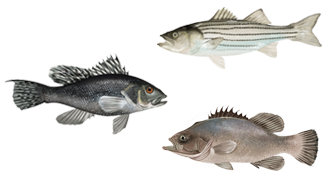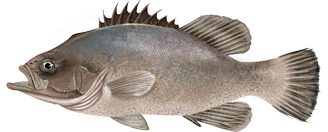Search for fish species near you
Use our map interface to search for species near you
LAUNCH THE MAP
in the u.s.
Wild-caught seafood is big business in the United States. Our fisheries provide more than a great meal - they provide jobs and recreation and help keep our coastal communities vibrant. From recreational and small-scale tribal fishermen to large-scale vessels harvesting and processing millions of tons of fish, U.S. fisheries are scientifically monitored, regionally managed, and legally enforced under 10 strict national standards of sustainability. Our dynamic, science-based management process is rebuilding depleted fish populations and maintaining healthy ones, benefitting fishermen, fishing communities, and our fishing and seafood industries.
Although at times complicated or controversial, our fisheries management system is one of the highest rated in the world. Today, we are turning a corner, heading toward a future where overfishing is a concern of the past and where maintaining sustainable fisheries is a shared commitment among stakeholders. However, we didn’t get here overnight - our nation’s journey toward sustainable fisheries began more than 35 years ago and continues to evolve.
The 1970s - the Birth of U.S. Fisheries Management

In the early 1970s, gasoline cost $.60 per gallon, the personal computer was just a concept, and federal management of marine fisheries was virtually non-existent. Federal activities were limited to supporting a patchwork of treaties governing international waters, which at the time were located only 12 miles off our nation’s coasts. In 1976, Congress passed the Magnuson-Stevens Fisheries Conservation and Management Act (now known as the Magnuson-Stevens Act). This Act extended the U.S. exclusive economic zone (EEZ) out to 200 miles, eliminated competition from the foreign fishing fleets off our coasts, and established our basic fisheries management system. By the late 1980s, however, Americanization of the fishing fleet and advancements in fishing technologies were now leading to the depletion of some of the nation’s most iconic fisheries. Adjustments to the Magnuson-Stevens Act were needed, and in 1996, the Act was amended to focus on protecting fish habitat and rebuilding fisheries. Since then, Congress has reauthorized the Magnuson-Stevens Act several times, each time building upon and strengthening the previous version to better conserve and manage our fisheries.
The Players
NOAA Fisheries is the federal agency responsible for managing fisheries in U.S. federal waters (3 to 200 miles offshore, or 9 to 200 miles offshore in the Gulf of Mexico). NOAA Fisheries scientists and managers work with regional fishery management councils to monitor fish populations and fisheries and set regulations to ensure sustainable harvests and practices. The councils include representatives from the fishing industry, environmental groups, states, and tribes. Much of our success in the United States is due to the involvement of our U.S. commercial and recreational fishing fleets and their commitment to the stewardship of our marine resources.
Coastal states are in charge of the fisheries that operate inshore (out to 3 miles, or 9 miles in the Gulf of Mexico). Interstate commissions help coordinate management among states in the same region. NOAA Fisheries and the coastal states and commissions support and advise each other and work together to ensure management is consistent across jurisdictions.
Last but not least, you, the public, have a role in our fisheries management process. It’s open for public participation through attending meetings, commenting on proposed management measures, serving on panels and committees, and providing data through cooperative research.
The Laws
More than 100 federal laws guide U.S. fisheries management. The Magnuson-Stevens Act requires that fisheries meet 10 national standards for fishery conservation and management. These standards work to sustain:
- Our fishery resources (fish and shellfish)
- The ecosystems in which they live (habitat and other marine animals)
- The people that depend upon these resources (commercial and recreational fishing industries and coastal communities)
Additionally, under the Marine Mammal Protection Act and the Endangered Species Act, NOAA Fisheries Office of Protected Resources is responsible for protecting marine mammals and endangered marine life from human impacts such as bycatch. Protected Resources staff work with the fishing industry to monitor fishing and develop or modify fishing gear and practices to minimize bycatch and its potential impacts.
NOAA Fisheries Office of Habitat Conservation works under dozens of statutes including the Magnuson-Stevens Act and the Fish and Wildlife Conservation Act to protect and restore coastal and marine habitat to support our nation’s fisheries. Like all animals, fish need a healthy living space, or habitat, to survive, grow, and reproduce. Much of this office’s work focuses on restoring sensitive coastal habitats impacted by development and pollution, affecting the productivity of fish populations.
The Road Ahead
U.S. fisheries are becoming more sustainable every year, as illustrated in our annual report to Congress on the status of U.S. fisheries. As part of this report, NOAA Fisheries has developed the Fish Stock Sustainability Index, or FSSI. Akin to the Dow Jones, the index provides a performance measure for the sustainability of the 230 most commercially and recreationally important species in the United States, which comprise 90 percent of what we catch. As shown in the FSSI, many overfished stocks are now rebuilt or actively rebuilding. Recent successes include: summer flounder, vermillion snapper, Atlantic sea scallops, lingcod, sablefish, and North Atlantic swordfish .
The index also illustrates the dynamic nature of managing fisheries. As many stocks rebuild, we also find that some decline, perhaps due to environmental conditions such as degraded habitat or because new information is discovered through improved monitoring and assessment methods. Our fisheries management system is built to respond and actively manage for these fluctuations.
In the 2012 fishing season, “annual catch limits” and accompanying “accountability measures” will be in place for all federally managed fisheries. Combined, these will work to actively monitor and prevent overfishing from occurring and, more importantly, require quick response by managers to make adjustments should overfishing occur. With the end of overfishing in sight, the U.S. fisheries management is at another turning point. Continued collaboration among all stakeholders is necessary as we address the difficult challenges ahead, including:
- Refining our management approaches to better meet the needs of fishermen and coastal communities
- Building on our world class science to better understand trends in fish populations and ecosystem considerations
- Taking stronger steps to preserve protected resources like endangered species and marine mammal
- Addressing habitat loss, pollution and environmental change, and their effects on our living marine resources
- Continuing to deal with global challenges including international illegal fishing practices that undermine the health and abundance of our global ocean resources















































